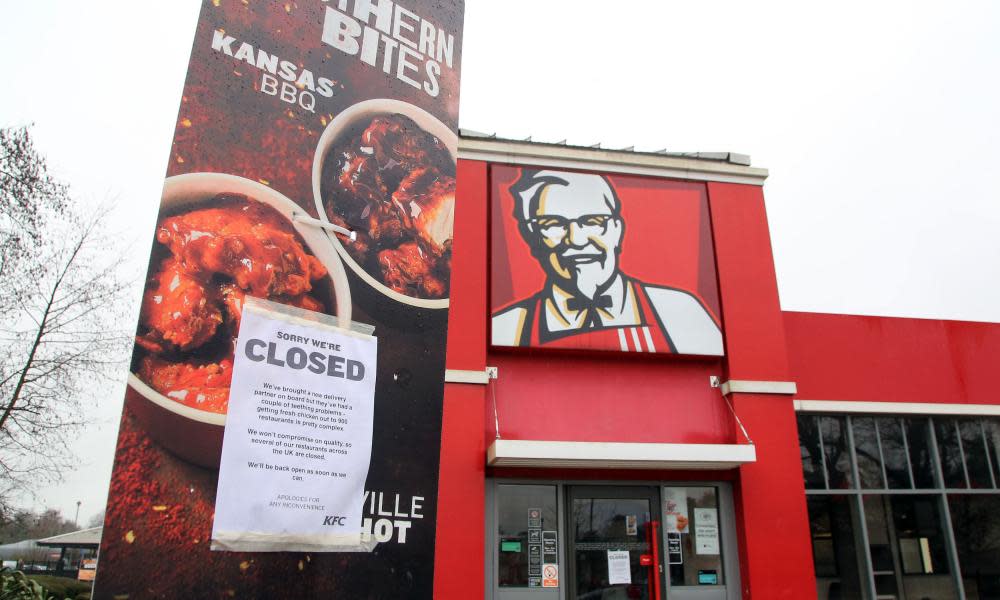'People have gone chicken crazy': what the KFC crisis means for the brand

At lunchtime on Friday, George Cheah, or George Junior as he is known, doesn’t really have the time to talk. “Honestly we are so busy, it’s gone absolutely mad. People have gone chicken crazy,” he says over the phone, while people shout orders in the background. Cheah’s family-run fried chicken joint, Chicken George in Luton, won best takeaway at the British Takeaway Awards in 2016 so they are never short of custom, but since the great fried chicken crisis of 2018 began more than a week ago they have been inundated.
“I reckon our business has doubled in the past week,” said Cheah. “We’ve been really, really busy, like packed. With KFC being shut, lots of people are tagging us on social media saying they’d rather have a George anyway.”
Chicken George is not the only takeaway straining under the demand for fried chicken as customers attempt to get their fix following the closure of most of KFC’s UK outlets earlier this week. The hashtag #KFCCrisis trended on Twitter, and no fewer than three police forces issued statements asking the public not to contact them about the closures. Police in Tower Hamlets issued a terse tweet:
Please do not contact us about the #KFCCrisis - it is not a police matter if your favourite eatery is not serving the menu that you desire.
— Tower Hamlets MPS (@MPSTowerHam) February 20, 2018
KFC was brief and somewhat sheepish in the statement posted in its shops, saying there had been “a few hiccups with the delivery today”. The crisis soon spread, however, leading the company to point the finger at its new logistics partners. “We’ve brought a new delivery partner on board, but they’ve had a couple of teething problems,” it said in a statement. There were reports of desperate managers attempting to bulk-buy chicken from supermarkets, and of frustrated attempts to give away surplus chicken in a storage depot that the local council confirmed had not been registered.
So where did it all go wrong? The “new delivery partner”, otherwise known as the behemoth DHL, took over the KFC logistics contract on Valentine’s Day, alongside Quick Service Logistics (QSL), which has supplied KFC in Europe since 2011. Problems began almost immediately. By 16 February, KFC had started to shut down locations after managers complained of delays to deliveries and by 18 February only 266 of 900 restaurants in the UK were open.
“I’ve never heard of anything go down so quickly, it’s been absolutely shocking,” said Dr Jonathan Owens, an expert in operations management and the supply chain at the University of Salford business school. “I think they’ve been caught out by the speed and the limited amount of space there is for error with such a highly perishable product.”

The logistics of fresh chicken are fiercely regimented, according to Owens. From egg to slaughter is around 35 days, with most chickens gassed, plucked, cut up into saleable pieces and distributed to temperature-controlled warehouses before being sent in refrigerated lorries to outlets. KFC sells around 676m pieces of chicken a year and buys 450,000 birds a week in the UK. An unspecified number are imported from other European countries, Brazil and Thailand, according to its website.
Much of the speculation for the cause of the disruption has centred on the fact that DHL has one centralised warehouse, in contrast to the previous contractor, Bidvest, a specialised food distributor that operated from six.
Malory Davies, the editor of Logistics Manager, said: “It’s not necessarily a bad choice to have one location, but the scale is the challenge. If you are serving 900 sites from one warehouse it’s difficult,” he says. “You would think if you team with a company you have worked with for years in Europe and pair it with the biggest logistics operator in the world it would be a safe bet. We are all agog to see what has actually gone wrong.”
For the moment, DHLremains tight-lipped about the fiasco. It apologised for the “unforeseen interruption” and said: “Whilst we are not the only party responsible for the supply chain to KFC, we do apologise for the inconvenience and disappointment caused to KFC and their customers by this incident.”
Richard Wilding , a professor of supply change management at the Cranfield School of Management, said the disruption revealed the extent to which companies have become compartmentalised. Henry Ford may have raised the cows used to produce the leather on his vehicles’ seats, but modern companies are more like football teams, with specialised players in individual roles. “Companies are no longer in competition with other companies. It’s the supply chains that are directly competing,” he says.
KFC say 800 or 900 stores are now open, and while neither KFC, DHL or QSL have given any indication of the financial damage the last week has caused, it’s likely to be significant. “Research suggests you get a big impact about 60 days after the event, and the drop in shareholder value can be in the region of 20%,” Wilding said.
Experts disagree on the reasons for the chicken shortage, but most agree that the damage done will be significant, if not evenly distributed among the companies involved. KFC’s marketing team has been praised for its careful handling of the crisis, particularly the judicial use of humour in tweets, and a full-page newspaper advert on Friday rearranged the letters on a chicken bucket from KFC to FCK. When rivals Burger King offered a disappointed KFC fan free food for a year, the company tweeted: “Putting all your chips on the table … bold move BK. When our chips arrive we will match your stakes and too put all our chips on the table. Until then we have limited chips.”


